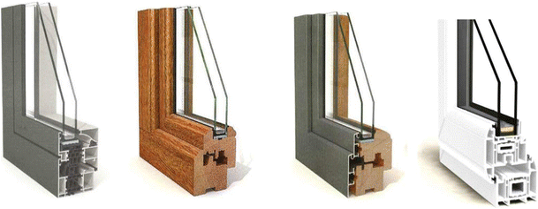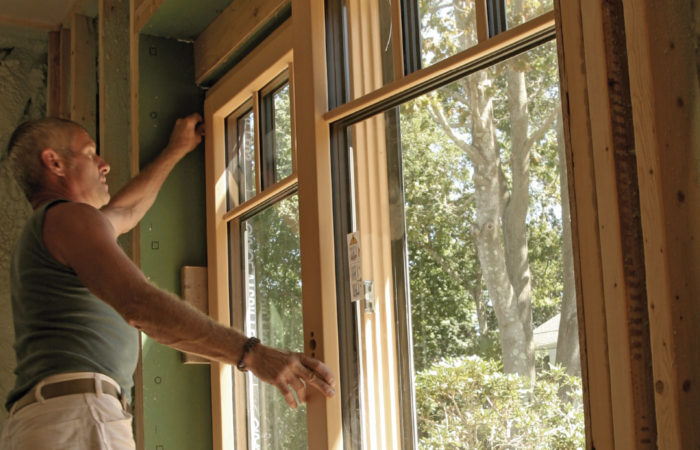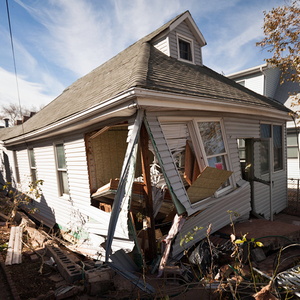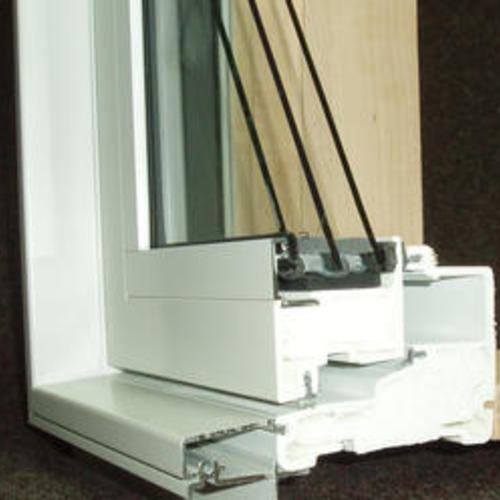Q I want to increase the R-value of the single-pane windows in my 44-year-old house in New Hampshire. I am considering using movable window insulation. Is this insulation good for limiting excess heat gain in summer? The windows also fog up easily. Will inner storm windows prevent the fogging and provide more R-value? Can you suggest other alternatives?
-Patrick Clary, Dover, N. H.
A Stan Griskivich, a window-insulation specialist in Yarmouth, Maine, responds: Movable window insulation would certainly help reduce winter heat loss, but the payback period could be long, depending on the type of insulation, heating system and Btu cost. If you build thermal shutters, the payback period will be shortened. Curtain shops may also carry a line of insulating curtains.
Movable window insulation requires that you take an active role opening and closing the shade or shutter during the heating season. Most people lose interest in this process after the first season (or sooner) and stop using the thermal shades or the shutters.
You should not use movable window insulation to reduce summer heat gain. Dark-colored insulating shutters or shades kept closed during a summer day, especially on the south or west side of the house, will have the opposite effect. Your windows and house will become solar collectors, which store and radiate heat. Shading the summer sun is best done with roof overhangs, exterior awnings or deciduous trees.
Adding inner storm windows can solve both problems. But first you must caulk and weatherstrip the existing windows. Cold-air infiltration can account for almost as much heat loss as the conductive loss through single glazing. Once you have sealed the windows, you could install inner storm windows. The key to preventing fogging is to get a tight seal around both windows so that there’s a dead-air space between them.…
Weekly Newsletter
Get building science and energy efficiency advice, plus special offers, in your inbox.

This article is only available to GBA Prime Members
Sign up for a free trial and get instant access to this article as well as GBA’s complete library of premium articles and construction details.
Start Free TrialAlready a member? Log in















22 Comments
Don't pull out your old windows
This issue of tearing out old windows is highly controversial and from what I am reading online today, the answer is NOT to tear out old windows. Definitive research from GreenBuildingAdvisor.com on this subject would be much appreciated.
Replacing windows is not cost effective
Pam,
It's almost never cost-effective to install new replacement windows. The cost of new windows is far more than the energy saved -- even if your are willing to wait decades to break even.
Read more on the topic here: "The Energy Efficiency Pyramid."
More advice on window performance improvement
Cold-climate homeowners interested in improving the performance of their windows should install exterior storms with low-e glass. Although many storm window suppliers don't realize it, it's easy to order single-glazed storm windows with a hard-coat low-e coating.
Researchers have confirmed that installation of low-e storms is the most cost-effective way to improve the performance of windows in cold climates.
You rock
Martin, you rock.
R+ Window Insulator
Patrick's comment about interior storm windows and Stan's solution reflect the options that most homeowners are faced with when wondering if they should replace their inefficient windows. I appreciate Martin's reference to the Energy Efficiency Pyramid because it helps define the order of energy improvements based on costs, complexity, and return on investment.
However, I have found a superior solution to exterior storm windows is the R+ Window Insulator in that it actually moves the corrective action down the pyramid into the air sealing and insulation categories by addressing those issues that occur within a window opening. It is cost effective at about 1/5th the cost of a window replacement and because of the self sealing gasket to the window trim it not only seals the air leaks, but because it not glass it does not transmit energy like glass and it turns a single pane window into a triple pane and a double pane into a quad pane.
Their web site says it will increase the efficiency by 15-40% and can be ordered with coatings to increase performance based on the specific application and climate considerations and best of all it doesn't require a ladder to install or remove or change the look of the exterior which is very important with historic preservation. http://www.proactiveenergyconcepts.com/rpluswindow.html
Your green Product Guide
Martin, I am willing to buy an online subscription to your green Product Guide to find out your recommendations on the best storm windows. However, I don't see any listed in the thumbnails you have online in the Windows section. Does that mean "all storms are alike" as long as you get Low-E? And what would you say about interior panels (you have one recommended) vs. exterior storms? Thank you, again!
Go to a local storm window dealer
Pam,
Storm windows are usually custom-made in small local shops; they are not sold and distributed by national window manufacturers. Go to a local storm window dealer with a good local reputation, and you'll be fine. Just be sure you get the low-e glass.
I'm not a fan of interior storm panels. They can trap moisture, leaking to mold problems or even rot. They also interfere with window operation; most exterior storms, on the other hand, can be opened or closed when ventilation is required.
Thank you!
Thank you!
New windows
Air sealing and additional insulation should always be the first line of defense. But sometimes it is better to bite the bullet and replace the window. Many of the single pane windows put in during the late fifties, sixties and seventies were poor quality production wood or aluminum windows. Aluminum was modern and exciting, you know bragging rights. These windows can never be sealed properly. This was a time when fuel was cheap and you just put in a bigger boiler. Weather sealing, water planes, thermal boundries, etc. were unheard of.
In some cases full window replacement gives an opportunity to correct a multitude of problems. They make the house quieter and many tilt in for cleaning, a safety concern. As far as storm and screens are concerned, totally useless against wind pressure. I have them over weighted 100 year old windows. When the wind blows 3 and 4 days straight they are a little better than leaving the windows open. Now what really worked was well made seperate storms and screens, but in the fall and spring they had to be changed out. I use to do over thirty of them twice a year. Many on the second floor off a wobbly ladder, with Dad at the bottom saying " come on, toughen up, why in the Army I used to have to do it with a ladder that had one short leg and every other rung was missing". The amount of time used to try to weatherseal a window or figure out how to correct the problem could be more costly then just replacing it. Oh yes, the reason I still have these weighted windows and have spent many, many hours attempting to fix and seal them? The love of my life just loves her old weighted, leaky windows, they have charm and they are old.
If your house is old, you need new windows
I've refurbished 60 old homes, and not one of them had all the windows that operated worth a darn. So I'd say the energy argument is out the window (sorry). You want windows that work, and any window that needs paint or sealer eventually stops working well.
There's an outfit operating in a few big cities that has a flat fee of $250 per window installed price for a decent vinyl window U=0.32. Size doesn't matter, they figure it averages out. At that price, the energy argument might be back on.
Most types of storm windows don't hold up in the long term. Half of those old homes had some sort of storm window, and again, after 20 years, 0% of them were working well.
I swear I don't work for that window company, but I do love their business model:
http://greenbuildingindenver.blogspot.com/2010/05/buying-new-and-retrofit-windows-in.html
Annual savings
Kevin,
Check out the Efficient Windows Collaborative Web site. In Chicago, switching from old windows with storms to new vinyl low-e double-glazed windows might save about $3 a year per window in energy costs. That means that if the window costs you $250, it will take you 83 years to break even.
If you prefer the look and feel of new vinyl windows compared to older wooden windows, and if you don't mind shelling out thousands of dollars, go ahead and buy new plastic windows. But don't expect that the energy savings will justify the expense.
And those new vinyl windows
And those new vinyl windows sure aren't going to last the 83 years that you are paying them back!
Efficient Windows website
Martin, where on the Efficient Windows website is the info about the amount of cost savings in changing out to vinyl windows? I just looked on it and couldn't find it and would like to be able to print it out to show people. Thanks.
Reply to Amanda
Amanda,
The best answer to your question will be found using RESFEN software.
The Efficient Windows Web site has a blunt tool that will display the basic idea. Click on the "Window Selection Tool" tab. You can then compare energy costs for "a typical (new or existing) 2000 sq. ft. house with 300 sq ft of window area (15% of floor area). The windows are equally distributed on all four sides of the house and include typical shading (interior shades, overhangs, trees, and neighboring buildings)." Select different window options to see the effects of your choice.
If you assume that each window measures 10 square feet, you can divide the savings shown by the tool by 30 to get per-window savings.
Unfortunately, the Web site displays results as a bar graph instead of a dollar number, making comparisons difficult. The tool also does not permit orientation-specific glazing choices.
adding to the landfill is green?
so if the pay back doesn't happen before you have to replace your replacement windows...why contribute to the landfill? In the case of a much older window, why throw old growth wood into the trash and then turn around and throw your vinyl replacement windows in the trash every 10 years after that? They call them "replacements" b/c you have to keep replacing them. Replacement windows are called "no maintenance" b/c you can't repair them.
Window Replacement
The EnergyStar program for new homes utilizes the Home Energy Rating System (HERS), which requires visual inspection of the construction, pressure testing and measurement of the home and the use of the REM-Rate software to simulate energy use. The HERS program can also be used for existing homes. To simulate the impact of new windows installed in a typical 1960’s house in Tennessee, I ran the REM-Rate program for an actual house with various types of windows: the existing single pane wood windows with storm windows, new double pane low-E, vinyl windows, and the worst case, single pane metal windows. The simulation calculated the energy use, which showed an annual cost saving spread between the options approximately equal to the cost of one new replacement window. This may not be the case for every house and every climate, but does illustrate the relative impact of window replacement on energy use.
Adequate insulation and air sealing are very important in energy conservation. In existing homes, visual inspection of attics and an infra-red camera inspection of walls can help determine the need for insulation. Leaks in existing heating and air conditioning duct work can have a very big impact on energy use. Some homeowners will focus on the energy efficiency of a new air conditioning unit, and not realize the amount of energy lost due to leaky and inadequate ductwork. Pressure testing of a home and its ductwork can help identify air leakage problems.
Replacement windows
Not all replacement windows are vinyl. Most companies are making wood replacement windows, some are just the 2 side chanels with a top and bottom sash. Please remember that statistics are just numbers, they are used as a sales tool to help sell or not sell something, in this case new doors or windows. Use common sense, start with air sealing and insulation, then proceed from there. Listen to the homeowner and observe conditions, in most cases the ones that need this help the most are in a catch-22. They are aren't making enough to afford a new furnace but are making too much to receive financial help from the government. Just maybe a new window could make their life easier like being able to open it or tilt in to finally be able to clean it. The human element can't be factored into the pay back equation. Use it as a guide to help in your quest to save energy.
New Window costs, storm window costs, window rehab costs.
Good points, Craig.
Again, I'm speaking as a home rehabber only. The window solution for the actual homeowner who lives in their home could be different.
I fix homes to resell. The windows must look really good and work perfectly. Thermal performance isn't that important, but most buyers will pay a little more for double glazed windows. If there are some windows that don't open and close, the home inspector will find it. Then the buyer will probably ask you to fix it, or at least give a credit of about $200 per window.
The homes I fix average about 70 years old. They either have the original wood windows or vinyl replacement windows. 90% of the original wood single hung windows work BADLY. If the vinyl windows are over 10 years old, yes, there is some maintenance and parts replacement required. This work costs about $50 per window.
The rehabilitation of the original wood window with about 10 layers of paint on it will cost about $200, and it won't be as tight as a new vinyl window. It will also still be a single glazed non low-e window that tends to cause some thermal comfort problems in that room.
You can add storms to the inside or outside, but 90% of them are lost or inoperable after 20 years.
I have tried all these different scenarios, and new windows are really the only option. And when the home is to be resold, it unfortunately turns out that the cheapest window is the most cost-effective. Consumer education may eventually change this. In some munincipalities, the home must be updated to the new energy code whenever it changes hands. That also solves the problem but adds the other problem of forcing the new price to be much higher, or cause the rehabber's margin to be slimmer. Too much government meddling IMO, not that you asked for it.
I was particularly disappointed in the wood window rehab route. Yes, the windows worked again, but they still looked BAD. They were simply to far gone for restoration, and that's the case in 80% of the homes I see.
In summary, the window must operate, the payback period is irrelevant. $250 each for new windows is worth it, but I can't spend more than that since it would be wasted money.
Lead Paint on Old Windows
Very sorry that I keep ranting on the this, but I forgot about the lead paint issue:
http://www.usatoday.com/news/health/2007-10-28-lead-cover_N.htm
I don't think most people will find it cost effective to completely remove the lead paint from their old wood windows. And the health risk is too high to just leave them there.
Light colored interior shades
I wanted to add a different viewpoint on light colored insulating shades. I have heard it said before that insulating interior shades will have the opposite effect desired. I'm not sure I agree from experience though.
We have installed light colored insulating cellular shades in all of our windows. We are very active in closing them at night to maintain interior temperature. We also close them in the summer to block direct summer light and open them in the winter to accept direct sunlight.
During the summer, the glass on the window may heat up a bit, but we are keeping the direct sun from heating the thermal mass in our house while the shade itself remains a normal temperature due to it being light. It also does not block all natural light and allows us to keep artificial lights off during the day.
Our house may be a bit unusual in that we have concrete floors and very dense drywall (2x 5/8" Type-X) where it may be in our best interest to let the glass get hotter rather than our high thermal mass surfaces that will retain the heat longer. All clients in our other homes have done the same thing and remarked on the increased comfort during the summer days and winter nights.
Personally, I'd love to see a more detailed analysis of interior window shades here in the future as this is they type of topic you guys delve into so well that many others gloss over.
Making storm windows
Is any of the plastic lumber stiff enough to make storm windows for an old house? I am thinking about a combination screen and storm. The frame would be routed out to hold a removable acrylic sheet. It would be held in place by the screen frame against the window. I would also need to find gasket material to seal this.
Response to Mimi
Mimi,
Making your own combination storm/screen units is tricky, and is very unlikely to save you any money compared to commercially available triple-track aluminum storm units installed by a storm window company.
Log in or become a member to post a comment.
Sign up Log in